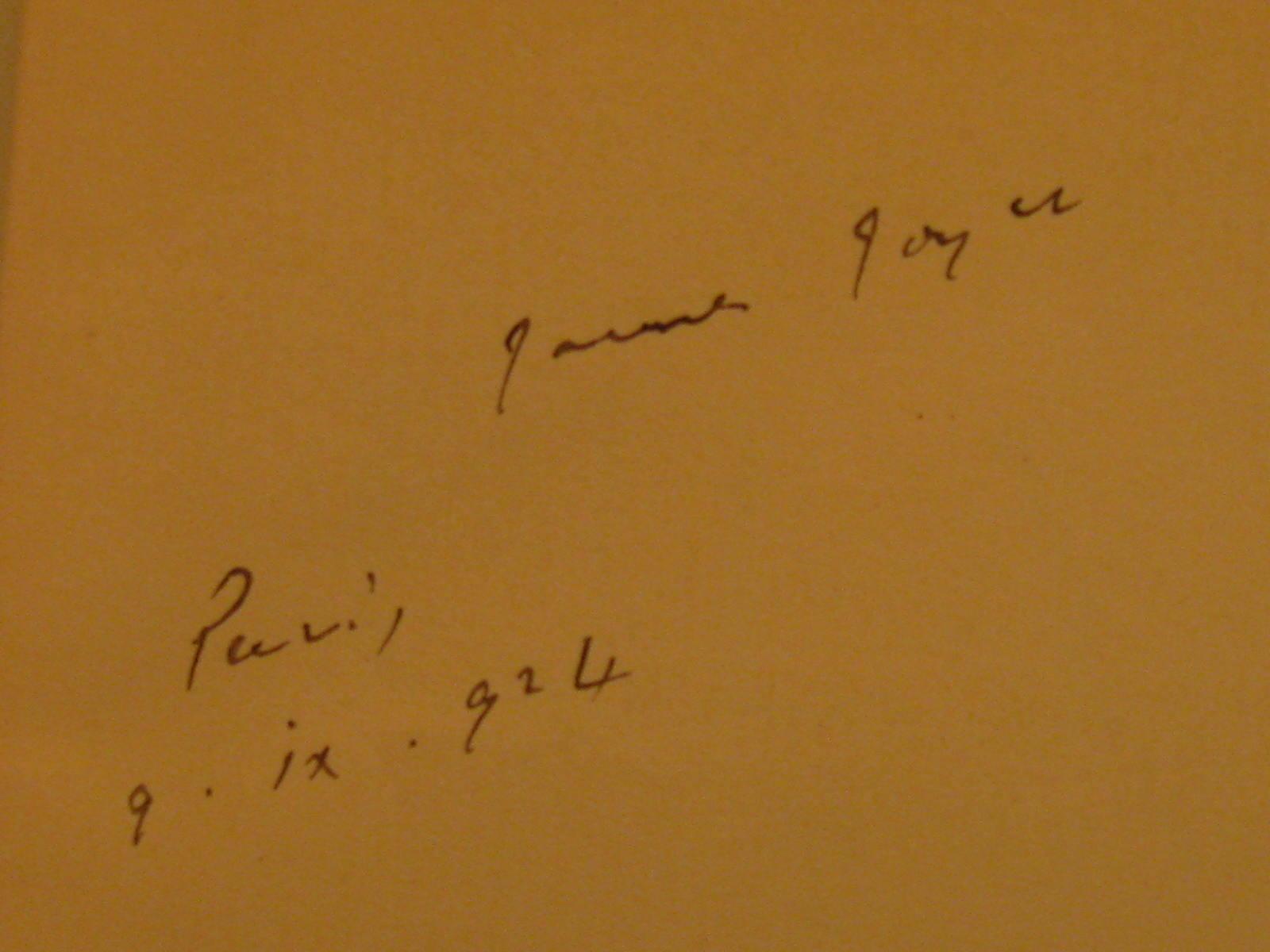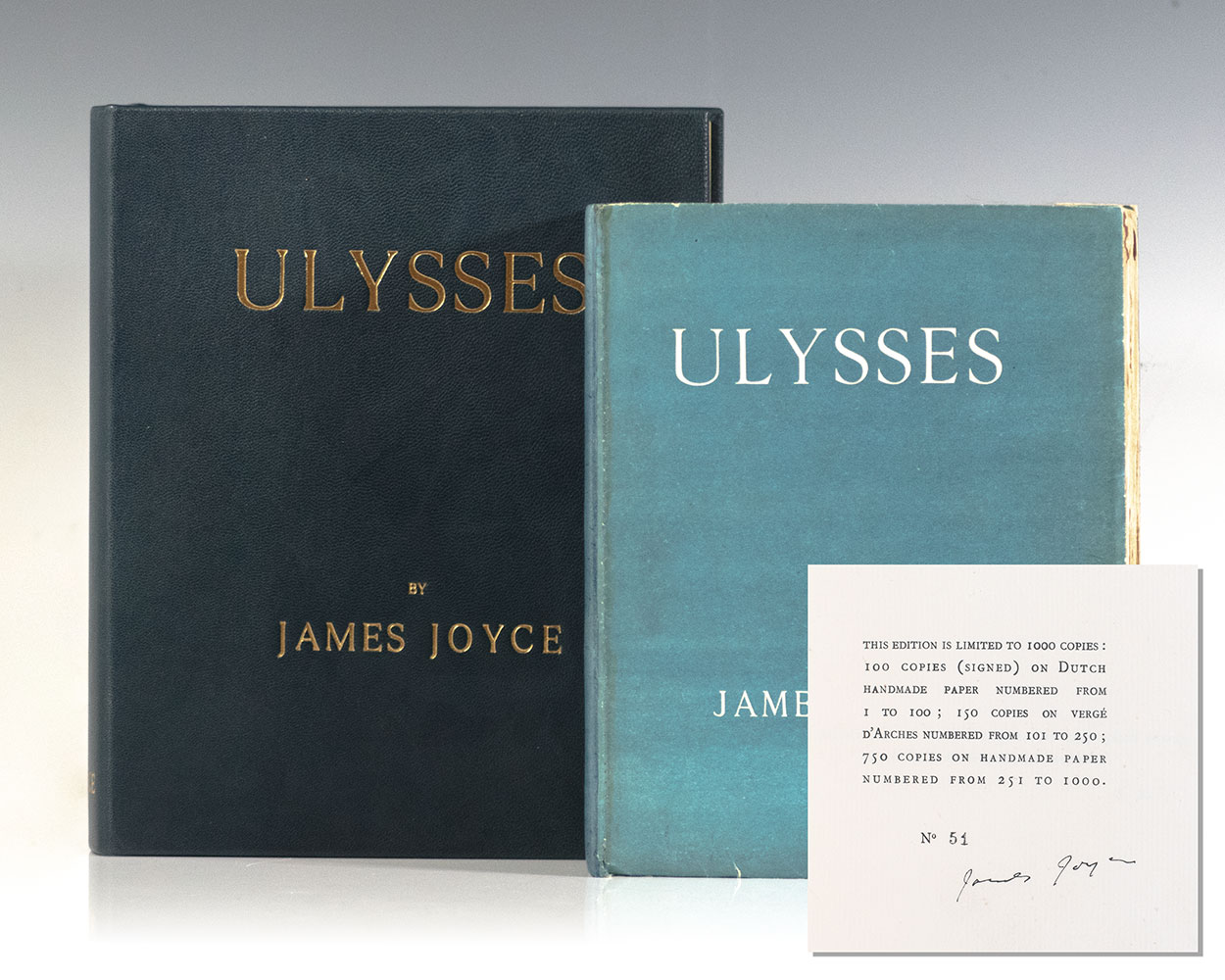Available Copies from Independent Booksellers

Price: US$75000.00 + shipping
Condition: Very Good
Description: Specially bound in full leather in 2 volumes. This is number 389 of a the special 750 copies printed on handmade, laid paper. Signed and dated in ink by James Joyce: "James Joyce, Paris, 9. ix. 1924" on the front endpaper following the front blue wrapper. Joyce's Signature has been authenticated by Glenn Horowitz of NYC. Volume I contains 370 pages. Volume II begins on page 371 and and ends on p. 732 with the "Trieste-Zurich-Paris, 1914-1921" dateline. The next page is printed in capital letters: "Printed for Sylvia Beach by Maurice Darantiere at Dijon, France." The rear wrapper is not present at the end of volume two. Both volumes have been specially bound in full leather with 4 gilt rectangular rules and a delicate inner rectangle of hand-tooled chain patterns culminating in larger floral designs at the inside corners of the front and rear boards. Both front boards bear the name of "JOAN" in vertical gilt capital letters. The spine of volume I is missing 6" of the 9.5" of the spine length, but the top portion with "I" is present. The front blue wrapper printed in White with "Ulysses" by James Joyce is clean and crisp, as is the text throughout volumes one and two. Apparently, the pages have been trimmed. The front blue wrapper measures: 9 x 7 All pages of text measure 9 x nearly 7. The right side margins measure 1.25; top margins measure 1 from the text to the top edge. The bottom margins measure a tad under 1.5. The left, inside margins measure .75 . The top edges are gilded. And there are predominantly orange and grey marbled endpapers. There is hand-tooled dentelle gilding along the front and rear inside edges of the boards as well. Both volumes have some pencil scrawls on the front endpapers, but nothing affecting the text. Despite the unusual two-volume format and the missing rear wrapper, modern first edition authority Allen Ahearn opined that this signed and dated copy in Joyce's hand of one of the 750 specially printed first editions is perhaps as scarce as one of the 100 signed copies, given that none of the 750 copies was issued with Joyce's signature. This copy was signed and dated two years after publication in 1924. This edition is limited to 1000 copies: 100 copies (signed) on Dutch handmade paper numbered from 1 to 100; 150 copies on vergé d'Arches numbered from 101 to 250; 750 copies on handmade paper numbered from 251 to 1000. This is copy No. 389. "The publisher asks the reader s indulgence for typographical errors unavoidable in the exceptional circumstances. S.B." In a review in The Dial, T.S. Eliot said of Ulysses: "I hold this book to be the most important expression which the present age has found; it is a book to which we are all indebted, and from which none of us can escape." He went on to claim that Joyce was not at fault if people after him did not understand it: "The next generation is responsible for its own soul; a man of genius is responsible to his peers, not to a studio full of uneducated and undisciplined coxcombs." The book has its critics; Virginia Woolf stated that "Ulysses was a memorable catastrophe immense in daring, terrific in disaster." Ulysses has been called "The most prominent landmark in modernist literature", a work where life's complexities are depicted with "unprecedented, and unequalled, linguistic and stylistic virtuosity." That style has been stated to be the finest example of the use of stream-of-consciousness in modern fiction, with the author going deeper and farther than any other novelist in handling interior monologue. This technique has been praised for its faithful representation of the flow of thought, feeling, mental reflection, and shifts of mood. (Wikipedia) First Edition, One of 750 numbered copies. Seller Inventory # 310
Seller: Brainerd Phillipson Rare Books, Holliston, MA, U.S.A.

Joyce, James. Ulysses.. Shakespeare and Company, Paris, 1922.
Price: US$300000.00 + shipping
Description: Signed limited first edition of Joyce's masterpiece, one of 100 numbered copies printed on handmade paper from a total edition of 1000 copies, this is number 51. Thick quarto, original blue and white wrappers. Laid in are the following pamphlets: Extracts from Press Notices of UlyssesÂby JamesÂJoyce" and the Shakespeare and Company prospectus for Ulysses, with woodcut vignette of Shakespeare, photographic portrait of Joyce tipped in. In near fine condition, rebacked. Housed in a custom full morocco clamshell box. An exceptional example. Ulysses was published in Paris by Shakespeare & Company, 1922. It was a struggle for the author to find a publisher, a comic irony considering that Ulysses is "[u]niversally hailed as the most influential work of modern times" (Grolier Joyce 69). Ulysses was an immediate success. The first printing sold out, and "within a year Joyce had become a well-known literary figure. Ulysses was explosive in its impact on the literary world of 1922" (de Grazia, 27). Even so, the book faced difficulties in global reception. It was banned in the U.K. and was prosecuted for the obscenity in the Nausicaa episode (Ellmann, 1982). Joyce's inspiration for the novel began as a young boy reading Charles Lamb's Adventures of Ulysses and writing an essay entitled "My Favorite Hero" after being impressed by the wholeness of the character (Goreman, 1939). The idea for the novel grew from a story in Dubliners in 1906, which Joyce expanded into a short book in 1907, before reconceptualizing it as the heady novel in 1914 (Ellmann, 1982). The book can initially seem unstructured and chaotic, and Joyce admitted that he "put in so many enigmas and puzzles that it will keep the professors busy for centuries arguing over what I meant" (The Observer, 2000). The French translator Stuart Gilbert published a defense of Ulysses shortly after its publication in which he supported the novel's use of obscenity and explained its internal structure and links to the Odyssey against accusations of ambiguity. Every episode, Gilbert explained, is connected to the Odyssey by theme, technique, and correspondence between characters. Another instance of Ulysses' literary contribution is his use of stream-of-consciousness, a technique employing carefully structured prose, both humorous and charactering, and involving puns and parodies. Joyce was a precursor to the use of stream of consciousness in the later decades. Similar narrative techniques were used by his contemporaries Virginia Woolf, William Faulkner, and Italo Svevo. Their style can be better characterized as an "interior monologue, rather than stream of consciousness, is the appropriate term for the style in which [subjective experience] is recorded, both in The Waves and in Woolf's writing generally" (Stevenson, 1992).
Seller: Raptis Rare Books, Palm Beach, FL, U.S.A.